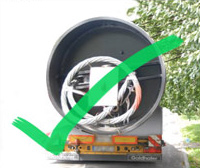FAQ (Frequently Asked Questions)
What is a divisible cargo? Resp. what is an indivisible cargo?
Law:
Germany: Allgemeine Verwaltungsvorschriften zur Straßenverkehrsordnung Vwv zu §29 StVO Absatz IV (extract):
“A permission only may be given if an indivisible cargo is to be transported or if several single pieces are to be transported, where each because of its length, width or height requires the use of a special vehicle; but in the latter case the admissible total weight and the admissible axle load must not be exceeded (§ 34 StVZO). A cargo is indivisible if its disassembly because of technical reasons is impossible or would cause unreasonable costs.”
Principally, the legislator only wants to give permissions for the particular use of the roads if it is really necessary. So they try to avoid the formation of heavy load transports by loading together normal transports.
Example:
For 1 tool 3, 00 x 2, 00 x 1, 00 m with 40 t unit weight, permission is granted.
For 2 tools with 3, 00 x 2, 00 x 1, 00 m with 20 t unit weight each no permission will be granted because this could be realized with two normal transports and without need of permission.
The same is valid not only for the weight but also for particular transport dimensions.
Example:
 A pipe/silo etc.
A pipe/silo etc.
13,60 x 3,00 x 3,00 m with 5 t
is possible without any problems, but…
 Two pipes/ silos etc.
Two pipes/ silos etc.
13,60 x 1,50 x 1,50 m with 2 t each
side by side is forbidden.
In the law there are some exceptions, so under certain conditions the counter-weights of mobile cranes are allowed to be loaded together. Under certain conditions smaller additional parts (e.g. an excavator bucket) may be transported together with the construction machines, at harvesters the cutter bar together with the basic device and similar cases.
This legislation according to special transports in more or less strong version and interpretation is valid in all European countries.
Which are the greatest dimensions and weights which are allowed to be transported on the road?
A question often asked according to heavy transports where unfortunately there is no clear answer.
It depends on the route, the total dimensions of the vehicle in loaded condition, the total weight and the axle weights.
Example:
A press head piece 6,00 x 4,00 x 3,40 m with 80 t in general is allowed to be transported in Germany.
Exactly the same piece but with 3, 80 m height instead of 3, 40 m will be much more difficult to be transported also in Germany because then you must use a much greater and heavier vehicle combination
As a rough standard you reach the limit of the possibility to carry out a heavy load transport in Germany at the following total dimensions (vehicle with cargo):
Total length: 35,00 m
Total width: 4,50 m
Total height: 4,40 m
Total weight: 120 t
Without any guarantee!
As you can watch on TV often much more is possible – well, the heavy load transports which cannot be carried out cannot be shown… Some examples exceed the limits of our capacities.
Please send us your request for your specific heavy transport problem.
With pleasure we tell you whether we are able to solve it.
